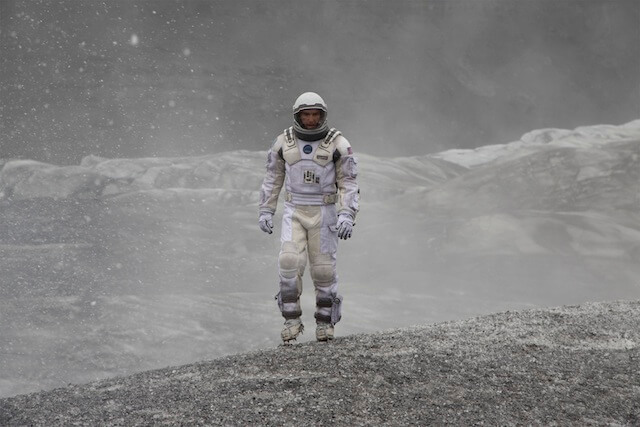‘Interstellar’ Filmmaker Christopher Nolan is the elementary school bookworm who also wants to play kickball. His films teem with science and logic puzzles, with crazed, mad ambition, stuffing mind-hurtlingly complex ideas into the biggest moneymakers of the modern age. They also, increasingly, show him…trying to be normal — the brainiac who’s a softie too. In “Memento” and “The Prestige,” there are dead wives and jilted lovers. But emotions were largely theoretical. With “Inception” he tried to marry the head and the heart. But his films — even at nearly three hours — are already overflowing with concepts and gimmicks and plot and characters. Is there even any room in there for pain and hurt and love? Is he even capable of such a thing? “Interstellar” is both the most emotional film he’s made and the closest to a balance between ideas and feelings. The ideas this time involve the environment, outer space, time, relativity, wormholes, five-dimensional living, unknowable, God-like beings right out of “2001: A Spacey Odyssey” and new understandings of gravity. The feelings are abandonment, death, the ravages of aging and that biggest mystery of the universe, love. The earth is dying from a mysterious ailment that has turned it into a mega-dust bowl. Its savior isn’t just your typical nerd; he’s Cooper (Matthew McConaughey), a good ol’ boy, All-American, studly engineer and pilot tasked with leading a super-on-the-DL NASA mission into another galaxy. He and crew (including Anne Hathaway and a couple expendables) are to cruise out to a wormhole by Saturn, dive through it and check out some planets that may be hospitable enough (or not) to become Earth 2. But this isn’t some populist sci-fi where that’s a warp speed jaunt away. It will take years to get to Saturn, then who knows how long to bounce from planet to planet. And the surface of each planet may force them to deal with relativity; an hour there may be a number of years on Earth. What’s worse, Cooper left behind two young kids, one of who, Murph, grows from young Mackenzie Foy (excellent) into Jessica Chastain (excellent). (There’s also a boy who grows up to be Casey Affleck, but the movie doesn’t seem to care about him. Nolan evidently can only care for one jilted kid.) Cooper is constantly on edge, his eye on the clock, wanting to get back before his kids are old (or dead). This is a long film that’s constantly worried about time passing, but it’s not self aware enough to turn that into a joke. But McConaughey helps. Cooper is tense and anguished, and — in the most nakedly devastating scene of Nolan’s entire career — a tear-soaked wreck. Yet Nolan lets him bust out an “alright alright alright”-styled hooray, and the actor is generally present and human in a film that’s often just scientists rattling off plot and explanations. Nolan still has problems with hand-holding — understandable, especially in this case, as this is a mega-epic about hardcore astronomy and cutting-edge physics. (“The Theory of Everything” has nothing on “Interstellar”’s science-speak, and that’s about Stephen Hawking.) He even at one point has a scientist use a folded piece of paper to demonstrate wormholes to someone who would know what a wormhole is. The harder “Interstellar” tries to marry brain to feelings the easier it is to sense that it’s just not Nolan’s bag. There’s a risible speech about love being provable whose only saving grace is that it’s faintly insincere. But it fares well with the Cooper-Murph business, notably because it doesn’t hold back on the darkness. Murph is furious her father ditched her; when she waits years with no radio contact — because he’s in hypersleep or fumbling about a planet — her anger turns to paranoia. It’s the only case where science and feelings line up — where Nolan found an organic way to use one of his gimmicks to get at something that hurts emotionally. There’s one time jump that’s like a shotgun to the gut — a moment as shocking and memorable and, in its way, perversely thrilling as any of the rewinds in “Memento.” It doesn’t hold back in other places either. There’s a strong sense of isolation and helplessness, conveyed not only in the script but in the visuals. Nolan is a zealot for film — please see this in 70mm, even if the IMAX, as ever, inelegantly toggles between different screen sizes* — but he’s not a strong imagist. He’s a right-brained materialist obsessed with structure and ideas, not a left-brained artist into texture. Even on 70mm (or even especially on it), parts of it are impossibly dark, borderline unparsable. (The best images in the first hour tend to be close-ups of ragged faces. As in “The Master,” 70mm is just as great with interesting faces as it is with awe-inspiring vistas, and Michael Caine, a way, way too brief William Devane and even McConaughey are faces worth scanning.) But when it gets to space things perk up. There’s a strong sense of the vastness of the universe made vaster thanks to the amount of black onscreen — negative space that dwarfs our human heroes. At one point Nolan shoots our heroes as a tiny dot floating in front of the gargantuan rings of Saturn. Even the tight confines of their spaceships helps convey the insignificance of man and of this mission. They’re just a junky little tin can rattling through the far side of the galaxy. Cooper is gung ho about survival, but even he is at the mercy of nature, and its many indifferent-to-humankind rules. Even moreso than other Nolans, “Interstellar” is the most practical blockbuster imaginable. And yet, like the worst stereotype of the scientists Nolan so clearly emulates, his ambitions can turn to hubris. He Hoovers up more cool, radical astrophysicist ideas than one film can reasonably handle. And he has no idea what to do with Hathaway’s astronaut, who starts off cold and tough before being reduced to a useless, sad-eyed wreck. (Gender politics are never great in Nolan films. Cooper’s salt-of-the-earth man’s man is the only real hero, with the women starting strong but reduced to pining for errant men.) The final third is a bust: a nutty Hail Mary that tries to tie this all up into neat, moving package. “Interstellar” is, for an event movie, peerlessly tough, but the finale intends to do the impossible: to find a heartwarming ending in a film that’s too dark — to pervert the laws of nature in order to defy them. That its characters don’t get the ideal ending counts for something; it winds up being a compromise. The same goes for the film — a wildly ambitious, thrillingly forward-thinking and, sadly, atypically brainy monster movie that has to settle for a lesser Plan B. No one’s pushing mainstream cinema as far as Nolan is, but one has to admit, by the standards he himself has laid out, that he doesn’t always get there.
Director: Christopher Nolan
Stars: Matthew McConaughey, Anne Hathaway
Rating: PG-13
3 (out of 5) Globes
Review: ‘Interstellar’ finds Christopher Nolan almost balancing the head and the heart

Melinda Sue Gordon, Paramount, Warner Brothers
Follow Matt Prigge on Twitter@mattprigge


















